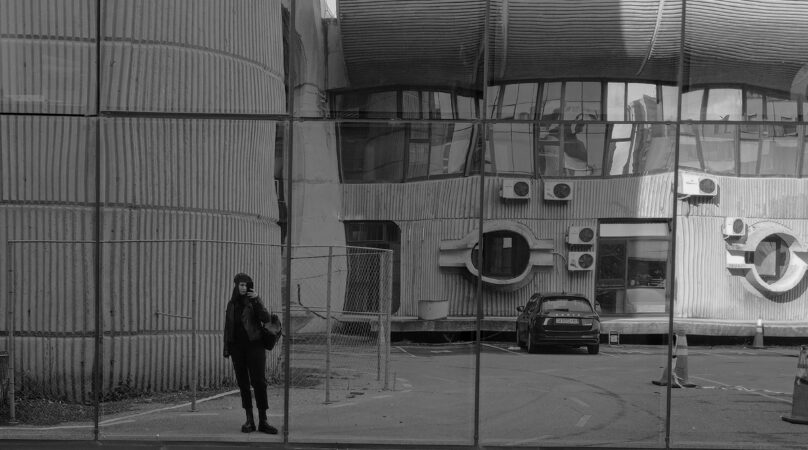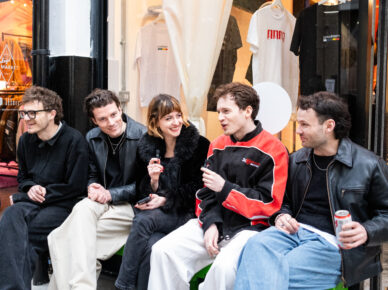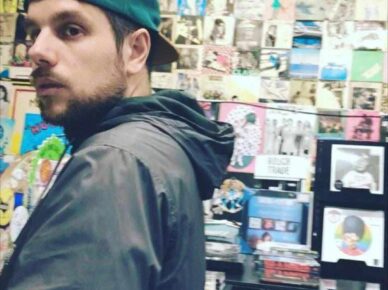Con Maya Petrevska, architetta residente a Skopje e gig-goer, ci siamo immersi in una lunga e articolata discussione tra brutalismo e musica.
A cura di Dario Damico e Maria Bek Petracca.
Musica e brutalismo è un binomio affascinante che trova facili incastri nell’immaginario collettivo. In particolar modo negli ultimi anni, questa corrente architettonica è tornata ad esercitare un forte magnetismo: basti pensare alle numerose pagine social che creano contenuti associando immagini di strutture brutaliste a canzoni, o alle varie band che hanno scelto quel tipo di iconografia per costruirsi una chiara identità visiva (le copertine dei tre album dei Molchat Doma sono i casi più famosi).
Per scavare dentro questo argomento abbiamo scelto di parlare con Maya Petrevska, architetta residente a Skopje ma anche appassionata di musica e festival, in modo da avere una visione tecnica e allo stesso tempo autentica, visto l’abbondare di costruzioni brutaliste nella sua città.
Qui trovate una playlist messa a punto da Maya stessa, la colonna sonora perfetta per fare una passeggiata tra costruzioni brutaliste.
***
[ITA]
Ciao Maya! Come vivi questo tipo di architettura in prima persona?
Ho un rapporto complesso di amore-odio con Skopje. Amo la mia città, ma non so cosa farne di questo amore poiché sento che essa non lo ricambia. Ho l’abitudine di girovagare per Skopje e, quasi ogni volta, rivisito qualche esempio della nostra architettura brutalista (e modernista). Mi sento come se nel vivere l’architettura brutalista venisse offerto un tipo specifico di libertà. Sperimentare l’architettura brutalista è come entrare in un parco giochi dove, in un certo senso, sei costretto a vedere oltre la manifestazione fisica della realtà architettonica, a guardarti dentro. Un parco giochi che ti dà la libertà di indagare la tua immaginazione.
Quando vivo l’architettura brutalista, mi sento come se fossi incappata in una scena di un film di fantascienza distopico, in cui l’edificio non è più un edificio ma una creatura vivente, una scultura che respira. C’è una certa serietà morale nell’architettura brutalista; si può quasi vedere e sezionare visivamente l’anatomia dell’edificio: quello che vedi è ciò che c’è. Ad esempio, l’acqua e l’elettricità non escono da inspiegabili buchi nel muro, ma vengono consegnate al punto di utilizzo tramite tubi visibili e condutture evidenti. C’è una vulnerabilità poetica nell’onestà dei materiali a vista e negli elementi strutturali che io rispetto, perché quei valori nella progettazione sono allineati con i miei valori di essere umano.
Secondo la tua opinione di architetto ed essere umano, che influenza ha sugli abitanti di Skopje vivere in una città ricca di brutalismo?
Ho una stanza con vista: la vista è un edificio brutalista. Crescere circondata da monumenti dell’architettura modernista ha evocato in me una sorta di curiosità che mi ha ispirata nel campo dell’architettura. Ma sono anche consapevole che non molte persone vedono il fascino degli edifici brutalisti. Quando pensiamo all’esperienza dell’architettura brutalista e modernista a Skopje, è importante tenere conto del contesto culturale, politico e storico in cui questi edifici sono stati costruiti.
Dopo il devastante terremoto del 1963, abbiamo avuto la possibilità, nel caso dell’architettura, di costruire una città in linea con le tendenze mondiali. Come diceva Zhivko Popovski, il mio architetto, professore, teorico e attivista macedone preferito: “avremmo potuto, e tuttavia abbiamo fallito nel tentativo di fare di Skopje una città moderna”. I giovani di Skopje ricevono un’educazione in edifici brutalisti (modernisti). Molte delle nostre scuole elementari, superiori e residenze universitarie sono costruite in questo stile. In un certo senso, siamo cresciuti interagendo e indagando il nostro rapporto con l’architettura brutalista, e quella è diventata la nostra zona di comfort. Molti giovani trovano abbastanza affascinante il carattere scultoreo ed espressivo di questo tipo di architettura, e la sensazione che sia “fuori luogo” nel contesto della nostra Città.
Tuttavia, molte persone accusano ancora l’architettura brutalista come un culto della Bruttezza, o la associano alla persistente connotazione politica dell’epoca in cui quelle architetture furono costruite. Ma, ai tempi, la modellazione del paesaggio urbano è stata realizzata da architetti di fama mondiale come Alfred Roth, Kenzo Tange e da architetti macedoni come Georgi Konstantinovski, Janko Konstantinov (che ha lavorato con Alvar Aalto), Zhivko Popovski (che ha lavorato con gli architetti olandesi di fama mondiale Jo Van Der Broek e Jaap Bakema ecc). Questi sono solo alcuni dei tanti importanti architetti macedoni che erano molto in anticipo sui tempi, visionari che amavano così tanto questa città da regalarle i loro capolavori modernisti, e che inserirono Skopje sulla mappa del Modernismo, in linea con le tendenze mondiali nel campo dell’architettura di allora. Questi individui, teorici, professori, attivisti mi rendono orgogliosa di definirmi una architetta macedone

Perché pensi che molte persone dell’Europa occidentale abbiano questa forma di attrazione verso il brutalismo dell’Est?
Se c’è una cosa che mi infastidisce è quando la gente parla di architettura modernista e quindi di architettura brutalista come “architettura comunista”. Sono consapevole che si tratti di mancanza di istruzione o ignoranza sull’argomento ma, nonostante le costruzioni siano nate all’interno di una specifica situazione politica, questo tipo di riferimento è completamente sbagliato.
Era Kenzo Tange, che ha progettato il Piano Regolatore di Skopje dopo il terremoto, un comunista? Erano Alison e Peter Smithson, leader del movimento brutalista britannico, comunisti?
C’è qualcosa di affascinante nella durezza delle strutture brutaliste dell’Est. Quando ci troviamo di fronte a qualcosa che è ridotto al minimo possiamo solo sperimentarne l’essenza, la crudezza delle emozioni associata alla completa libertà di interpretazione. L’esperienza dell’architettura brutalista impone alcune domande esistenziali in noi.
In un certo senso, parla degli aspetti più esistenziali e persino più oscuri della nostra persona. Quando sperimentiamo l’architettura brutalista, ci stiamo spogliando e stiamo affrontando i nostri sentimenti repressi, il nostro trauma (sia collettivo che individuale), il terrore esistenziale occasionale e le paure. Tutto ciò può essere abbastanza liberatorio.
Cosa rimane oggi dell’architettura brutalista a Skopje?
Vedo ancora Skopje come un labirinto brutalista, che offre uno spazio per sognare a chiunque osi entrare in un luogo pressoché distopico ma allo stesso tempo mitico. Girovagare per la città ed esplorare i suoi resti è una delle mie attività preferite e quasi magiche. Gli esempi di architettura brutalista (e modernista) a Skopje sono qualcosa di autentico e genuino e rappresentano le contraddizioni della vita in generale: nascita, morte, amore, cattiveria, conforto e paura, e noi che siamo bloccati negli spazi intermedi.
Uno dei miei capolavori brutalisti preferiti è il Macedonian Opera and Ballet del gruppo architettonico sloveno Biro 71. Ogni volta che visito questo edificio e lo osservo, mi sento come se fosse fatto solo di un mucchio di stelle che desiderano fragilità e tenerezza, ma sono bloccate in questo spazio tra mito e realtà.
Oppure quando visito il Centro delle Telecomunicazioni, progettato dall’architetto Janko Konstantinov, parte integrante del piano di Kenzo Tange per la ricostruzione di Skopje dopo il terremoto del 1963. Visitare questo capolavoro ti fa sentire come se stessi visitando un palazzo fatto di sogni e paure: ci si sente come se la luna fosse nascosta dentro una delle sue stanze.
Purtroppo, il costante abbandono di questi edifici porta al loro decadimento. Parlo della nostra eredità brutalista e creo narrazioni di stelle, sogni e lune nascoste e li rivisito nelle mie passeggiate come atto contro l’oblio, come atto di resistenza. E, ogni volta che vedo lo stato in cui versano questi edifici, mi sembra di vedere le ferite della mia città, di poterle anche toccare, ma mi sento anche una delle poche a sentirne il dolore.

Pensi che alcuni edifici possano essere convertiti in luoghi per la musica?
Decisamente! Mi emoziono così tanto solo pensando al potenziale del riutilizzo. La qualità atmosferica che questi edifici possiedono è straordinaria e, se venissero associati a qualche forma di utilizzo artistico, otterremmo un’esperienza magica e uno spazio attraente per i giovani creativi.
Una delle migliori esperienze che ho mai avuto è stato quando ho visto un saggio performativo e interdisciplinare in una parte del Centro delle Telecomunicazioni. Mi piacerebbe andare a un concerto di alcuni dei miei gruppi post-punk o darkwave preferiti nel contesto specifico di alcuni edifici brutalisti, penso che questo porterebbe l’esperienza di un concerto a un livello completamente nuovo.
E quali sono le band che, per il loro sound, assoceresti all’immaginario brutalista ieri e oggi?
Quando faccio i miei piccoli tour a Skopje in inverno tendo ad ascoltare i suoni oscuri di Molly Nilsson perché in un certo senso si adattano all’intera narrativa delle contraddizioni che è l’architettura brutalista.
Molly Nilsson abbraccia la solitudine, lo strazio e la paura esistenziale, ma allo stesso tempo abbraccia la speranza, la vulnerabilità e la solitudine come strumento generativo per trovare la tua voce autentica.
I Molchat Doma hanno anche costruito un’estetica e un suono associato al brutalismo dell’Europa orientale, a volte suona duro e freddo ma riesce a trasmettere un’atmosfera specifica; essa può essere compresa solo da chi ha avuto esperienze simili e incuriosisce quelli che non hanno familiarità con quel tipo di estetica. E poi direi la musica di Anika, ma anche Anika nell’ambito del progetto Exploded View possono essere visti come un modo più morbido di come suonerebbe il brutalismo.
La musica dei Nurnberg e degli Human Tetris oscilla tra l’oscurità, l’esistenzialismo e la desolazione, trasmettendo allo stesso tempo il messaggio sul nostro bisogno assolutamente umano di superare la paura dell’amore. Penso che l’atto di indagare la complessità dell’esperienza umana esplorando gli estremi sia ciò che collega l’architettura brutalista alla musica post-punk/darkwave.
Vuoi citare anche anche qualche band macedone?
Una delle band che mi rende orgogliosa e che fa parte della nostra eredità darkwave sono i Padot na Vizantija. Erano una delle band macedoni più influenti degli anni ’80 che sperimentarono il post-punk e la darkwave occasionalmente incorporando elementi musicali bizantini. Nella loro famosa canzone Sepak istata sostojba il mix di darkwave ed elementi bizantini, con testi poetici ma esistenziali, dà vita ad un suono autentico.
Un’altra band che amo sinceramente sono i Mizar. Ogni tentativo di definirli non rende giustizia al loro sound d’avanguardia, che oscilla tra diversi generi, mescolando post-punk, elementi del folklore macedone, darkwave ed elementi bizantini. Alcune delle mie canzoni preferite dei Mizar sono Devojka od Bronza, Pocesna Strelba e Magla.
Infine una delle scoperte più belle di quest’anno è stata la musica di ATA. L’ho vista dal vivo al nostro amato MKC ha solo tre canzoni ma è assolutamente geniale, sfida generi e definizioni. Questa musica mi fa provare la sensazione intangibile dell’esistenza attraverso l’assenza.
Pensi che ci sia qualcosa che non sia completamente oscuro in questa idea musicale di brutalismo?
Né l’architettura brutalista, né questi generi musicali (post-punk/darkwave/synthpop) si sottraggono alcupo e malinconico, facendoci rivolgere verso noi stessi e affrontare la pesantezza che portiamo dentro di noi. Eppure trasmettono il messaggio di amore, speranza e tutte le cose meravigliose che rendono la vita degna di essere vissuta. In un certo senso, sezionano e ci mostrano l’esperienza umana nel modo più genuino e onesto, facendoci affrontare alcune domande esistenziali ma anche ispirandoci a diventare più vulnerabili e onesti.
Per concludere, credi che questa connessione tra musica e brutalismo possa essere utile ai paesi dell’Est? Può creare un interesse turistico e artistico che possa estendersi a tutte le forme di cultura?
SÌ. Nel contesto di Skopje, se ben curato, può diventare un museo brutalista misterioso e interattivo attraverso i percorsi in città.
La città intera può divenire un grande parco giochi, un laboratorio per esplorare e creare nuovi significati, raccontando la storia brutalista di Skopje a qualsiasi appassionato interessato. Associato a spettacoli artistici all’interno o intorno a questi edifici, con concerti e mostre, il percorso brutalista di Skopje potrebbe generare un nuovo modo di vivere la città.
[Grazie mille a Maya per questa interessante discussione. Aspettando di rivederci nuovamente ad Ypsigrock la prossima estate.]

***
[ENG]
How do you personally experience this type of architecture?
I have a complex, love-hate relationship with Skopje. I love my City but I don’t know what to do with this love since I feel like my City doesn’t love me back. I have a habit of wandering around Skopje and almost every time I revisit some example of our brutalist (and modernist) architecture. I feel like in the process of experiencing brutalist architecture you are offered a specific type of freedom. Experiencing brutalist architecture is like entering a playground where you are, in a way, forced to see beyond the physical manifestation of the architectural reality, forced to look inward. A playground that gives you the freedom to investigate your Imagination. When I experience brutalist architecture, I feel as if I have stumbled into a scene from a dystopian sci-fi movie where the building is no longer a building but a living creature, a breathing sculpture.
There is a certain moral seriousness in brutalist architecture – you can almost see and visually dissect the anatomy of the building – what you see is what you get. For example, water and electricity do not come out of unexplained holes in the wall, but are delivered to the point of use by visible pipes and manifest conduits.
There is a certain poetic vulnerability in the honesty of the exposed materials and structural elements of brutalist architecture
In your opinion as an architect and a human being, what influence does living in a city full of brutalism have on the people of Skopje?
I have a room with a view – the view being a brutalist building. Growing up surrounded by landmarks of modernist architecture evoked some sort of curiosity that might have informed my gravitation toward the field of architecture. But I’m also aware that not many people see the appeal of brutalist buildings. When we think about the experience of brutalist and modernist architecture in Skopje, it’s important to take into account the cultural, political, and historical context in which these buildings were built. After the devastating earthquake in 1963, we had the chance, in the context of architecture, to build a City that is in line with the world trends.
As my favorite Macedonian architect, professor, theorist and activist Zhivko Popovski used to say: “We could have and yet we failed in the attempt to make Skopje a modern City”. The youth in Skopje is being educated in brutalist (modernist) buildings. Many of our elementary schools, highschools and student dormitories are built in this style. In a way, we grew up interacting and investigating our relationship with brutalist architecture and that became our comfort zone. Many young people find the sculptural, expressive nature and the feeling of this type of architecture “being out of place” within the context of our City quite fascinating.
Many people though still accuse brutalist architecture as being a cult to Ugliness or they associate it with the lingering political connotation of the era in which they were built. But back then the shaping of the urban landscape was made by world-renowned architects like Alfred Roth, Kenzo Tange and Macedonian architects like Georgi Konstantinovski, Janko Konstantinov (who worked with Alvar Aalto), Zhivko Popovski who worked with the world-famous Dutch architects Jo Van Der Broek and Jaap Bakema etc.
These are some of the many prominent Macedonian architects who were way ahead of their time, visionaries who loved this City so much that they gifted the City their modernist masterpieces and pinned Skopje on the modernist map, in line with the world trends in the architecture field back then. These individuals, theorists, professors, activists make me proud to call myself a Macedonian architect.

Why do you think many Western European people have this form of attraction towards Eastern Brutalism?
If there is one thing that annoys me the most when people talk about modernist architecture is calling modernist and therefore brutalist architecture “communist architecture”. While I am aware of the lack of architectural education and prevalent ignorance, and although it was built within that specific political situation, referring to brutalist and modernist architecture as “communist” is completely wrong. Was Kenzo Tange, who designed the Master Plan of Skopje after the earthquake a communist? Were Alison and Peter Smithson who led the British brutalism movement communists?
There is something fascinating in the harshness of the brutalist structures of the East. When we are faced with something that is stripped down to the core and we can only experience the essence, the rawness of emotion paired with the complete freedom of interpretation . The experience of brutalist architecture imposes some existential questions on us. In a way, brutalist architecture speaks to the more existential and even darker aspects of our persona. When we experience brutalist architecture we are stripping down our persona and we face our repressed feelings, our trauma (both collective and individual), the occasional existential dread, and the repressed fears. This can be quite liberating.
What remains of Brutalist architecture in Skopje today?
I still see Skopje as a brutalist labyrinth, offering a room to dream to anyone who dares to enter an almost dystopian yet mythical place. Wandering around the City and exploring its brutalist remains is one of my ultimate favorite and almost magical activities. The examples of brutalist (and modernist) architecture in Skopje are something authentic and genuine and they represent the contradictions of life in general – birth, death, love, spite, comfort, and fear and us being stuck in the in-between spaces.
One of my favorite brutalist masterpieces is the Macedonian Opera and Ballet by the Slovenian architectural group Biro 71. Every time I visit this building and observe it I feel as though it is made of nothing more than a heap of stars that long for fragility and softness but are stuck in this space between myth and reality.
Or when I visit the Telecommunication Center, designed by architect Janko Konstantinov. The Telecommunication Center is an integral element of Kenzo Tange’s plan for the reconstruction of Skopje after the earthquake in 1963. Visiting this brutalist masterpiece makes you feel like you’re visiting a palace of dreams and fears – you feel as if the moon is hidden in one of its rooms.
Unfortunately, the constant neglect of these buildings leads to their decay. I talk about our brutalist legacy and I make narratives about stars and dreams and hidden moons and I revisit them in my walks as an act against forgetfulness, as an act of resistance. And every time I see the state that these buildings are in I feel as if I can see the wounds of my City, I can even touch them but I also feel like I’m one of the few who feels the pain.
Do you think some buildings could be converted into music places?
Definitely! I get so excited just thinking about the potential of adaptive reuse of brutalist architecture. The atmospheric quality that these buildings possess is extraordinary and if you pair them up with some form of artistic use, we will get a magical experience and an attractive space for young creatives. One of the best experiences that I ever had was when I saw a performative, interdisciplinary essay in one part of the Telecommunication Center. I would love to go to a concert of some of my favorite post-punk or darkwave bands in the specific setting of some brutalist building – I think that that would take the experience of a concert to a whole new level.

What are the bands you would associate for their sound with brutalist imagery yesterday and today?
When I have my little tours around Skopje in winter I tend to listen to the dark sounds of Molly Nilsson because it sort of fits the whole narrative of contradictions that brutalist architecture is. Molly Nilsson embraces both loneliness, heartbreak, and existential dread but at the same time, she embraces hope, vulnerability, and solitude as a generative tool for finding your authentic voice and learning how to create from that point of authenticity.
Molchat Doma also built an aesthetic and sound that is associated with Eastern European brutalism, sometimes sounding harsh and cold but always conveying a specific atmosphere that only someone with similar experiences can truly understand but that intrigues the ones who are not familiar with this aesthetic.
The music of Anika, but also Anika as part of the collaborative project Exploded View, can be seen as a softer way of how brutalism would sound.
The music of Nurnberg and Human Tetris oscillates between, on one hand, gloom, existentialism, and desolation while also conveying the message about our utterly human urge to overcome the fear of love. I think that the act of exploring the complexities of the human experience by exploring its extremes is what connects brutalist architecture and post- punk/darkwave music.
Would you also name some bands from Macedonia?
One of the bands that make me feel proud and are part of our darkwave legacy is Padot na Vizantija. They were one of the most influential Macedonian bands in the 80s that experimented with post-punk and darkwave while occasionally incorporating Byzantine music elements. In their famous song “Sepak istata sostojba” the mix of darkwave and Byzantine elements, with poetic yet existential lyrics results in an authentic sound.
Another band that I genuinely love is Mizar. Every attempt to define them won’t do justice to their avant-garde sound, oscillating between different genres, blending post-punk, elements from the Macedonian folklore, darkwave, and byzantine elements. Some of my favorite songs from Mizar are Devojka od Bronza, Pocesna Strelba and Magla.
One of the best discoveries this year was the music of ATA. I saw her live performance at our beloved MKC (Youth Cultural Center) last year and she only has three songs so far: Mrtva Voda Ziva voda (Мртва вода Жива Вода), Lakrimarium (Лакримариум) and Sredba/Dopir (Средба/Допир)) but she is absolutely genius, defying genres and definitions.
This music makes me feel the intangible feeling of existence through absence.
Do you think there is something that is not completely dark in this musical idea of brutalism?
Neither brutalist architecture nor these genres of music (post-punk/darkwave /synthpop) shy away from the gloomy and melancholic, making us turn inward and face the heaviness that we carry within us. Yet, they convey themessage of love, hope, and all the wonderful things that make life worth living. In a way, they dissect and show usthe human experience most genuinely and honestly, making us face some existential questions but also inspiring us to become more vulnerable and honest.
And finally, do you think this connection between music and brutalism can be useful to Eastern countries? Can it create tourist and artistic interest which then extends from music to all forms of culture?
Yes. In the context of Skopje, if done well, it can become an attractive, mysterious, and interactive brutalist museum, following the brutalist trail across the City. The whole City can become one big playground, a laboratory for exploring and creating new meanings, retelling the Skopje brutalist story to any interested enthusiast. Paired withart performances in or around these buildings, with concerts and exhibitions, the brutalist trail of Skopje can become a generator for a new way of experiencing the city.
[Thanks so much to Maya for this interesting discussion. And we look forward to seeing you again at Ypsigrock next summer.]

SEGUICI
Web • Facebook • Instagram • Twitter • Spotify • Telegram
Anika architettura ATA brutalismo Human Tetris Intervista Macedonia Maya Petrevska Mizar MOLCHAT DOMA Molly Nilsson Skopje
Last modified: 22 Febbraio 2024


















